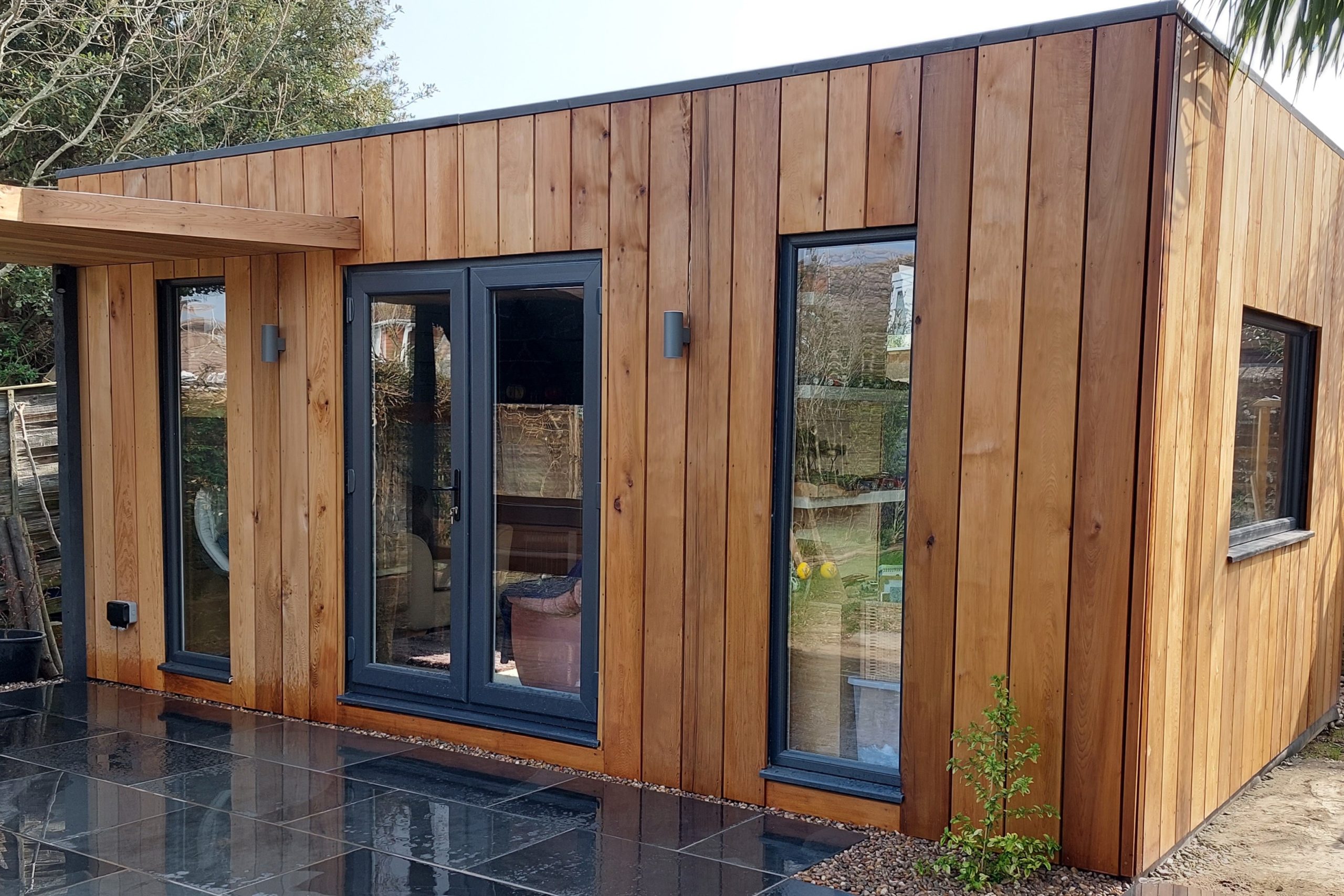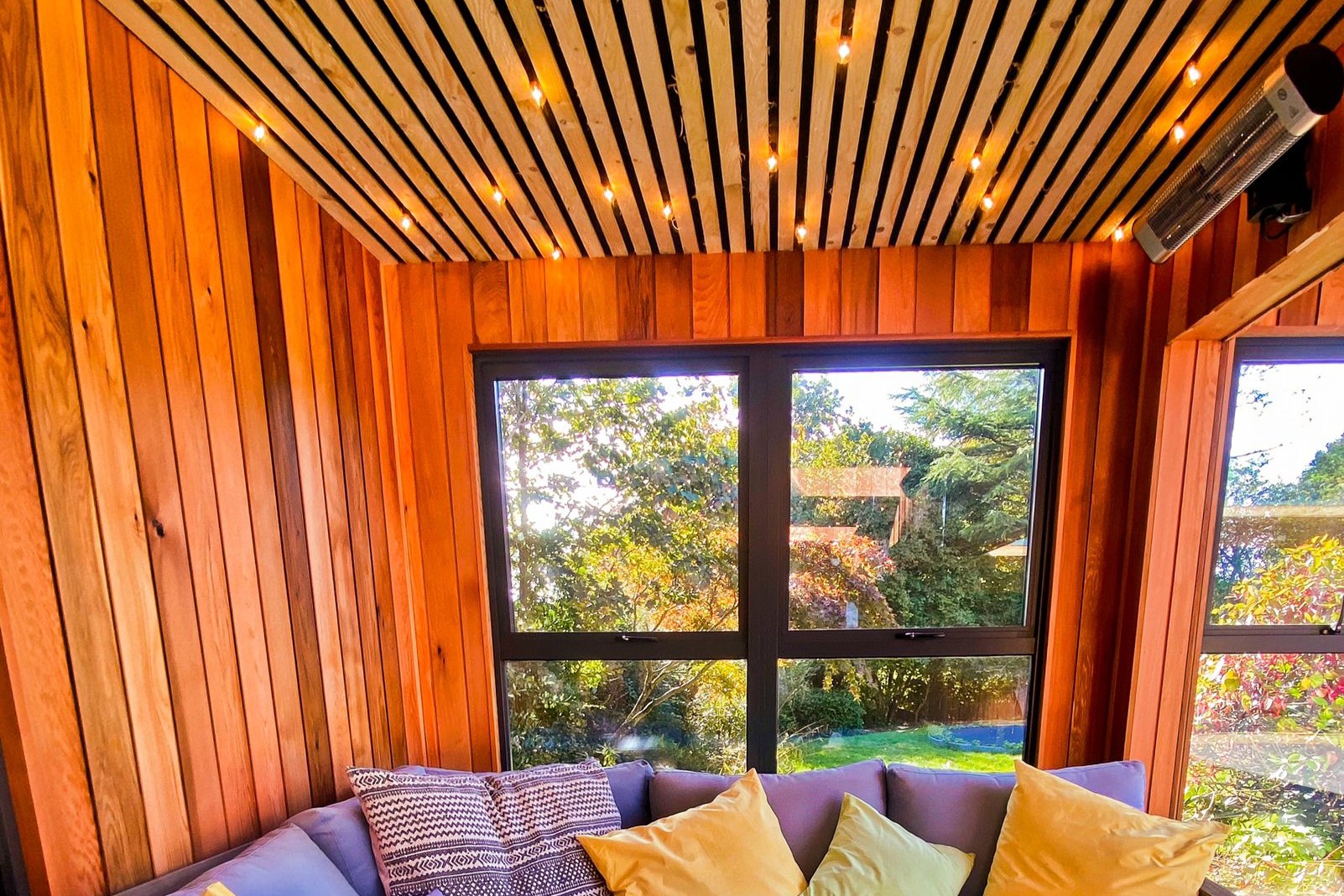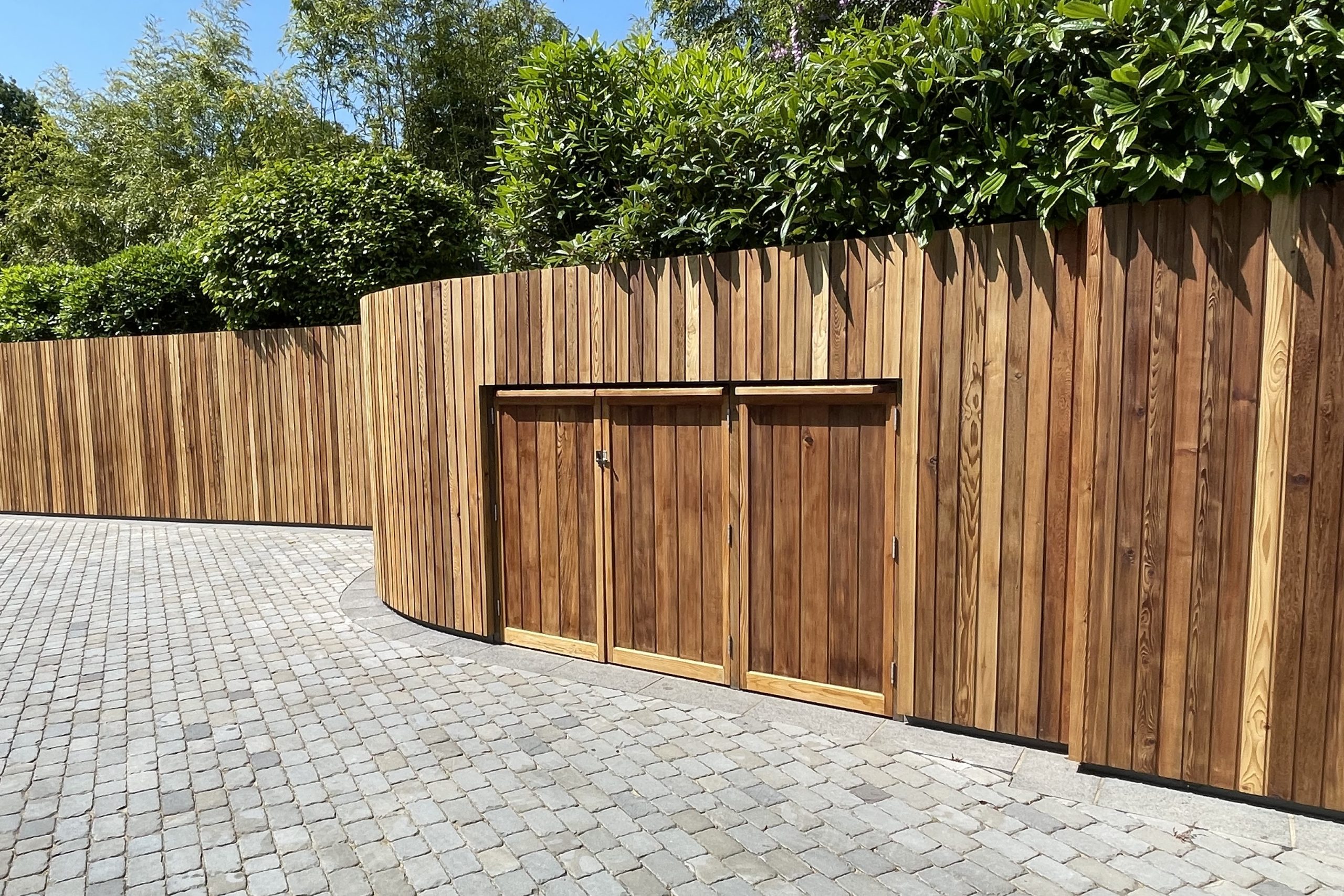Larch - Feather edge - 140 x 18mm
Product Code: C-000120£25.71 per m² ex. vat
Lengths available:
- 1000mm
Enter your cladding area for estimate price:
Area
Price (Based on 1000mm)
Contact our experts for a price including delivery and recommended fixings:

We believe in the power of premium materials to transform spaces, inside and out.
We strive to deliver your products as promptly as possible, so you can start enjoying them right away.
Our customers are at the heart of everything we do. That’s why we are proud to showcase our Trustpilot reviews.
Shopping with us is straightforward and stress-free. Our dedicated team is just a call or email away if you need assistance.
This cladding is available in continuously changing lengths , please give us a call to discuss your requirements|Siberian Larch T, G, & V Cladding: 140 x 22mm
Cladding is an increasingly popular method for giving your home, office or garden a lift. Comes in various lengths.
Our efficient delivery system ensures your softwood cladding reaches you in excellent condition and on time. Delivery charges are calculated based on your postcode, the size, and the weight of your order. Whether we use external couriers or our own fleet of vehicles, we take great care in packaging and handling. For more information, please see our Delivery Terms & Conditions.
Overview: Choosing the Right Profile
Softwood cladding offers an attractive and cost-effective solution for exterior and interior applications. Popular softwood species like pine, larch, and spruce provide natural beauty and versatility at accessible price points. The installation method depends on the profile selected—shiplap, featheredge, tongue and groove, or open gap—each with its own aesthetic and fixing requirements. Proper preparation and installation are essential to ensure longevity, weather resistance, and visual appeal.
Preparation and Acclimatisation
Before installation, allow the softwood boards to acclimatise on-site for at least 48-72 hours. Store them flat, off the ground, and protected from direct sunlight and moisture. Timber naturally swells and shrinks as moisture is absorbed and lost, seeking to reach equilibrium with the surrounding environment. Ensure the wall structure is weatherproof and that battens or counter battens are installed to allow for ventilation behind the cladding.
Fixing Methods
Face Fixing (Traditional Method) The most common method for softwood cladding. Use stainless steel annular ring shank nails or round head nails for secure fixing. The nail length should be at least 50mm or 2.5 times the thickness of the board being fastened, whichever is larger. Nails should be punched just below the wood’s surface. Stainless steel fixings prevent discolouration and rust marks, particularly important for high-tannin timbers.
Secret Fixing Ideal for tongue and groove profiles, providing a clean, uninterrupted surface. Nails or fixings are inserted through the tongue or rebate, hidden by the next board. This method creates a seamless appearance with no visible fixings.
Installing Shiplap Cladding
Shiplap boards feature a curved lip and overlapping design for excellent water resistance:
- Can be installed horizontally or vertically (horizontal is more common)
- Maintain minimum 10mm overlap with 2mm expansion gaps between upstands to allow for timber movement
- Install with tongue facing upwards to prevent water collection
- Use face fixing or secret fixing through the rebate
- Creates distinctive shadow lines for a traditional or contemporary aesthetic
Installing Featheredge Cladding
Featheredge boards are tapered and overlap for a traditional weatherproof finish:
- Designed for horizontal installation only
- Allow at least 35mm overlap per board (50mm is recommended)
- Each board must be fixed independently to allow for expansion and contraction
- Expose the fine sawn face rather than planed face for better treatment retention
- Ideal for rustic, rural-inspired projects including barns and outbuildings
- Seal all cut ends to prevent moisture ingress
Installing Tongue and Groove Cladding
Tongue and groove creates a tight, interlocking fit with smooth appearance:
- Can be installed horizontally, vertically, or diagonally
- Install with grooves facing downward to avoid holding water
- Maximum face width of 150mm recommended
- Allow 2mm expansion space above the tongue
- Creates weatherproof seal suitable for both interior and exterior use
- V-groove variation creates distinctive ‘V’ shadow lines between boards
Installing Open Gap Cladding
Open gap boards create modern, clean lines with visible spacing:
- Recommended gap of 8-15mm between boards
- Consult manufacturer for non-staining fixings and gap width specifications
- Use UV-resistant breather membranes behind cladding
- Install insect mesh to prevent pest entry
- Fixings will be visible—use quality stainless steel for aesthetic finish
- Allows depth and texture while maintaining airflow
Board Spacing and Movement
Softwood requires adequate spacing to accommodate natural movement:
- Shiplap: 2mm expansion gaps between upstands
- Tongue and groove: 2mm expansion space above tongue
- Open gap: 8-15mm between boards
- General spacing: Allow for seasonal expansion and contraction of timber
Ventilation and Sub-Frame Requirements
Proper support structure and airflow are critical for longevity:
- Use pressure-treated softwood battens minimum 38mm x 50mm (finished size)
- Space battens 400-600mm apart centre-to-centre
- Horizontal cladding requires vertical battens; vertical cladding requires horizontal battens
- Install vertical counter battens for additional drainage and ventilation where needed
- Angle top edge of horizontal battens to shed water
- Use UV-resistant breather membrane appropriate for your profile type
- Install insect mesh at all open cavities
- Maintain adequate cavity ventilation to prevent moisture accumulation
Fixing Specifications
Follow these guidelines for secure, long-lasting installation:
- Use stainless steel grade 304 fixings (316 for coastal areas) to prevent rust and staining
- Pre-drill fixing points at board ends to prevent splitting
- Position fixings minimum 20mm from board ends and edges
- Boards 100mm and wider require two fixings per batten intersection
- Boards under 100mm require one central fixing per batten
- Ensure battens extend full width of boards for proper support
- Countersink fixings for cleaner appearance
- Butt joints should always meet on suitable batten support
Maintenance and Protection
Softwood cladding benefits from regular care to maintain appearance and performance:
- Apply high-quality wood preservative or stain to protect against weathering and UV damage
- Seal all cut ends, sides, and fixing holes prior to installation
- Clean surfaces periodically with soapy water to remove dirt and prevent mould growth
- Reapply treatments every 2-5 years depending on exposure to rain and UV
- Check annually for signs of damage, rot, or insect activity
- Touch up any areas showing degradation
- Timber will naturally weather and may show colour variations—this should gradually even out
Professional Installation Tips
Optimal installation timing is during autumn and winter when weather is more temperate. Avoid moisture traps in design and cut vertical board ends at an angle to allow water to drip freely. Any sapwood present should be placed at the rear of cladding to maintain natural durability. Choose profiles carefully—not all are suitable for vertical installation.
Need Help?
While professional installation is advised for best results, we’re here to support DIYers with profile-specific advice and technical guidance. For maintenance tips or product recommendations, our team is always on hand to assist. Contact us for tailored support to suit your project.
Overview: European Larch Decking and Cladding
European larch is prized for its natural durability and beautiful warm colouration, combining the strength you need with the aesthetic appeal you desire. Popular for both decking and cladding applications, larch offers excellent value and performance. With proper maintenance, larch can last for decades, making it an excellent investment for your outdoor and exterior projects.
Natural Characteristics
European larch is moderately durable with good decay resistance. This hygroscopic timber naturally interacts with its environment, making it well-suited for exterior applications:
- High resin content provides natural protection against the elements
- Hygroscopic nature means timber absorbs moisture from air on rainy days
- Releases moisture when exposed to sun and wind
- Natural expansion and contraction during moisture cycles
- Characterful cracks and splits develop, adding authentic natural appearance
- Dense hardwood-like properties despite being a softwood
- Good structural strength for its weight
Weathering and Colour Changes
Understand how larch naturally ages over time:
- Without treatment, larch weathers from golden-brown tones to attractive silvery-grey patina
- UV rays and moisture exposure cause natural colour change over 6-18 months
- Weathered grey patina is considered distinguished and timeless by many
- North-facing surfaces and shaded areas may weather more slowly
- Initial colour variation between boards will gradually even out
- Natural ageing process does not affect structural integrity
- Many homeowners embrace the natural weathering aesthetic
Protective Treatments
If you prefer to preserve the original warm colouration of your larch, protective treatments are highly recommended:
UV Protection Oils
- High-quality semi-transparent stains and oils provide UV and water protection
- Penetrate wood to prevent growth of wood-decaying fungi
- Maintain warm golden-brown tones and prevent silver-grey weathering
- Reapply every 1-3 years depending on exposure
Clear Waterproofing
- Maintain natural appearance while offering moisture protection
- Allow wood to weather naturally while slowing the process
- Protect against water penetration and staining
- Reapply every 1-2 years
Pigmented Finishes
- Semi-transparent stains enhance natural beauty and grain
- Provide robust protection against UV rays and moisture
- Available in natural larch tones or custom colours
- Longer protection intervals of 3-5 years possible
Initial Treatment (Before or Immediately After Installation)
For best results, treat larch boards before or immediately after installation:
- Apply treatment to all surfaces including ends, edges, and backs
- Pay special attention to cut ends—seal immediately to prevent moisture ingress
- Choose treatments suitable for your specific application (decking or cladding)
- Allow adequate drying time before exposing to weather or foot traffic
- Treating before installation provides optimal protection
- High resin content means surface preparation is important for treatment adhesion
Regular Maintenance Schedule
Keep your European larch in prime condition with routine care:
Annual Inspection
- Check for debris accumulation between boards
- Inspect for signs of damage, splitting, or wear
- Ensure proper drainage and ventilation
- Look for mould, algae, or moss growth
- Examine fixings for corrosion or loosening
- Check for resin bleed in warm weather
Periodic Cleaning
- Clean surfaces 1-2 times per year with soft brush and mild detergent solution
- Remove dirt, algae, moss, and organic debris
- Rinse thoroughly with clean water
- Avoid pressure washers which can damage wood fibres
- Allow to dry completely before applying treatments
- Remove any surface resin with appropriate cleaner if necessary
Treatment Reapplication
- Reapply stains and sealants every 1-3 years for high-exposure areas
- Reapply every 3-5 years for protected or low-exposure areas
- Clean surface before reapplication
- Apply in dry, temperate conditions (avoid direct hot sun)
- Follow manufacturer’s coverage rates and application instructions
- Ensure good penetration given larch’s resinous nature
Ventilation Requirements
Proper airflow is critical for longevity and prevents moisture-related issues:
- Ensure adequate ventilation beneath decking to prevent moisture accumulation
- Maintain minimum 150mm clearance from ground to underside of deck boards
- Install cladding with ventilated cavity using battens or counter battens
- Avoid trapping moisture behind boards
- Use breather membranes that allow vapour transmission
- Keep vegetation trimmed back from timber surfaces
- Good airflow helps manage larch’s hygroscopic moisture cycling
Common Issues and Solutions
Address minor problems before they become major:
Surface Mould or Algae
- Clean with proprietary timber cleaner or diluted detergent solution
- Scrub gently with soft brush
- Rinse thoroughly
- Allow to dry and reapply protective treatment
Greying or Fading
- Clean surface thoroughly
- Lightly sand if necessary to remove weathered layer
- Apply UV-protective oil or stain to restore colour
Splitting or Checking
- Minor splits and checks are natural characteristics that add character
- Do not affect structural integrity
- Seal larger splits with flexible wood filler if desired
- Ensure proper treatment to minimize further movement
- Natural result of moisture cycling in hygroscopic timber
Water Staining
- Usually temporary and will blend as timber weathers
- Clean affected areas and reapply water repellent
- Ensure proper drainage to prevent standing water
Resin Bleed
- Natural occurrence in warm weather, especially when new
- Wipe away excess resin with white spirit or turpentine
- Reduces over time as timber ages
- Not a defect—natural characteristic of resinous timber
Longevity and Performance
With proper installation, treatment, and maintenance, European larch provides excellent service life:
- Decking applications: 50+ years with regular maintenance
- Cladding applications: 50+ years or longer with proper care
- Naturally durable heartwood provides good resistance
- Regular maintenance significantly extends lifespan
- One of the most cost-effective and sustainable choices for exterior timber
- Excellent strength-to-weight ratio for structural applications
Professional Maintenance Tips
Optimal maintenance timing is during spring and autumn when weather is temperate. Avoid applying treatments in direct sunlight, extreme heat, or when rain is forecast within 24 hours. Keep records of treatment dates and products used for reference. Consider professional cleaning and refinishing services for large or complex installations. Be aware that larch’s resin content may require specialized cleaning before retreatment.
Need Help?
European larch offers the perfect balance of natural beauty, durability, and value—providing you with an outdoor space or exterior finish to enjoy for generations to come. For maintenance product recommendations, treatment schedules, or specific care advice, our team is always on hand to assist. Contact us for tailored support to suit your project.






